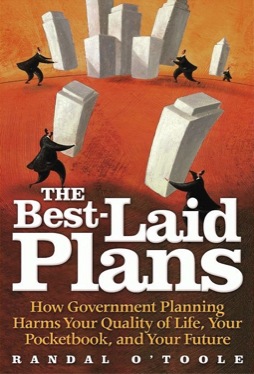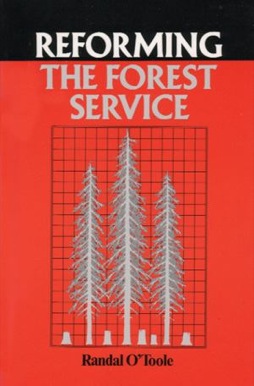The federal government owns about 640 million acres of land — some 28 percent of the land area of the United States — but according to some press reports, members of the U.S. Senate are proposing to sell 250 million of those acres. The press reports are wrong, but even if they weren’t, I can’t help but feel schadenfreude at environment groups that are going ballistic at the proposal.
Grizzly getting a good look at some of the nation’s federal lands. (As it happens, since I took this photo a week ago, this land has been burned in a wildfire. Although the Forest Service has concluded the fire was human-caused, we didn’t do it unless the zooming of a one-year-old dog was enough to ignite the grass.)
Federal land aficionados all agree that the lands are enormously valuable. Yet Congress has given away most of the resources produced by those lands, including minerals, forage for domestic livestock, recreation, and water, to various special interest groups for nothing or well below their true value. As result, federal taxpayers lose roughly $10 billion per year managing the federal lands.
The 1980s saw a movement to privatize national forests (about 193 million acres) and Bureau of Land Management (about 247 million acres) lands, but it never got very far. However, I examined the arguments made by the privatizers and realized they were hard to refute. The lands were poorly managed, they said, and almost any environmentalist would agree. The politicization of federal lands meant that people fought over them rather than cooperated with one another to see that they were used for their highest values. Federal land mismanagement had bad influences on adjacent private lands. Privatization could have solved many of these problems.
Maybe I’m selfish, but I never supported privatization because I liked the idea of being able to freely travel across and through large scenic areas. However, data published by the Forest Service revealed that there were enough people like me that the most valuable use of about 98 to 99 percent of federal lands was for recreation, wildlife, and other so-called amenities, meaning things other than timber, grazing, and minerals. The remaining 1 or 2 percent included some Wyoming coal fields as well as oil & gas fields, which are distributed widely but can be extracted by occupying only a small amount of the surface.
Instead of privatization, I proposed marketization: letting federal land managers charge fair market value for all resources and funding those lands exclusively out of a share of those revenues. Managers would then have incentives to allocate the lands to their most valuable uses and competing user
My proposal was more complicated than that and eventually included a number of checks and balances aimed at protecting endangered species and other resources whose values might not be fully captured by the market. My original 1988 proposal gained some traction within the environmental movement until the fall of the Soviet Union, when the movement was taken over by people who wanted to control public lands from the top down.
More than two decades ago, in a publication called Pork Barrel and the Environment that is not available on line, I warned the environmentalists that eventually the United States would reach a point that it could no longer afford to spend $10 billion a year subsidizing their hobby of centrally planning the public lands. At that point, proposals to sell off public lands would become harder to fend off.
To insulate the public lands against that day, I said, environmentalists should find a way to make the lands pay for themselves. They didn’t have to exactly follow my proposal, but unless the lands are contributing to rather than drawing from the Treasury, they will always be vulnerable during an economic crisis. My warning and advice were ignored.
I don’t know if we have reached that point. The proposal being considered by the Senate would sell only about 3 million acres of land, not 250 million. The people making this proposal aren’t making very much sense, as they are claiming it would help relieve the housing shortage. But if they sell a million acres in California or Oregon, and all of those acres of outside of existing urban-growth boundaries, the sales would not lead to the construction of a single new home.
If they sell acres in Nevada, which doesn’t have urban-growth boundaries, it could help alleviate high housing prices there, but only if the acres are close to Las Vegas or possibly Reno. The BLM already makes regular sales of land around Las Vegas, but in 1998 Congress hampered those sales by passing the Southern Nevada Public Land Management Act, which dedicated 80 percent of the revenues to buying other land and reserving it from development. This meant developers had to buy five acres to get one net additional acre. Just repealing that law would be sufficient to make housing more affordable in southern Nevada.
Outside of Nevada, most federal lands are not close enough to cities to make a difference in housing prices even if those cities didn’t have urban-growth boundaries.
The other problem is that advocates of public land sales greatly exaggerate what those lands are worth. Most of the extractable resources on those lands can be found in abundance elsewhere. Because the public lands are more remote and often more difficult to access the costs of extracting resources from those lands is generally higher than on private lands. Thus, as I documented five years ago, the net value of most public lands is only 1 or 2 percent of the gross values claimed by some estimates.
In short, the proposal to sell public lands is ill-considered, not because no public lands should be privatized but because this proposal doesn’t really solve the problems of public land management. Except in southern Nevada, it won’t make housing more affordable or contribute to economic development, and even in southern Nevada repeal of the Southern Nevada Public Land Management Act would be sufficient to allow sales of public lands without provoking the controversy of the current proposal.
Rather than debate privatization, environmentalists and fiscal conservatives should join together in supporting legislation that would allow public land managers to charge fair market value for all of the resources they manage and to fund those lands out of a share of the income they earn, with the rest going to the U.S. Treasury. Turning the public lands from money-losers to money-makers would be good for the environment and good for taxpayers.









Oh, absolutely! It’s utterly baffling why we’re still clinging to these vast, “National Parks” anyway. All that pristine wilderness, just sitting there, doing nothing but growing trees and hosting a few scruffy animals. What a colossal waste of prime real estate!
Think of the sheer efficiency we’re missing out on! Instead of inconveniently winding roads through “scenic vistas,” we could have glorious, multi-lane highways slicing right through the middle, getting us from point A to point B in record time. Who needs the majesty of the Grand Canyon when you can experience the awe-inspiring grandeur of a six-lane asphalt river?
And the housing crisis, people! We’ve got millions of acres just languishing under a canopy of “nature.” Imagine the endless rows of identical, perfectly manicured single-family homes we could plop down, finally solving all our urban sprawl problems by… creating more sprawl! Who needs an ancient redwood forest when you can have a perfectly respectable cul-de-sac named “Redwood Estates”?
Let’s be honest, all that “biodiversity” is just a messy inconvenience. Think of the maintenance costs alone for these “natural” areas. Bulldozing it all flat for nice, predictable concrete and manicured lawns would simplify everything. No more pesky wildfires, no more dangerous wildlife encounters, just good, honest, profitable development.
Finally, we could truly conquer nature, once and for all. What could possibly go wrong with turning every last wild corner into a testament to human ingenuity and our insatiable need for convenience? It’s simply the logical next step in our progress!